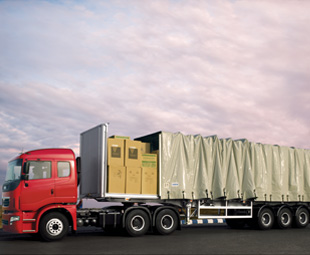No heavy going for heavies

Commercial vehicles are the life force of our country, enabling the transport of both people and goods within, and across, our borders. JACO DE KLERK takes a look at the heavies of these important machines.
The South African commercial vehicle market has delivered steady and consistent growth in the first half of the year, with June as the second best single month in terms of sales.
This year’s youth month saw sales of a total of 2 552 trucks, buses and vans with a gross vehicle mass (GVM) of 3 501 kg or more reported to the National Association of Automobile Manufacturers of South Africa (Naamsa). Estimates were made by combining the results released by Naamsa, Associated Motor Holdings and Amalgamated Automobile Distributors as well as the Naamsa estimate, by segment, for deliveries by Mercedes-Benz SA based on historical trends and forecasting as the company only reports aggregated sales figures.
On a year-to-date basis, this vital vehicle segment logged 13 878 sales for the first half of 2012 – 738 more than last year’s 13 140 for the corresponding period. This amounts to market growth of 5,6 percent, despite some challenging macro economic conditions.
Of the 2 552 units sold during June, 473 were heavy commercial vehicles (HCVs) with a GVM rating between 8 501 kg and 16 500 kg, and 116 were passenger buses with a GVM above 8 500 kg. This marked a one percent margin, to 2 380 units, of positive growth for HCVs over the first half of the year, reassuring to hear after this segment’s negative year-on-year growth for May.
According to Dr Casper Kruger, vice president of Hino South Africa, this welcome recovery in the total volume performance of HCV sales indicated an improvement in the availability of Japanese trucks, which forms the backbone of this segment. “While this category’s year-to-date market share remains well below its long-term average at 17,4 percent,” says Kruger, “the distribution sector, which purchases the great majority of the heavier 4×2 units that make up the HCV population, is now in a better position to pursue normal fleet expansion and replacement activities.”
 He notes that bus volumes have recorded a year-to-date improvement of 9,1 percent – a figure worth mentioning – when compared to their equivalent January-June 2011 performance. “While some of this has been driven by a large-scale order for city buses placed by the Ethekwini Municipality,” says Kruger, “the general picture for bus sales in 2012 has been more positive than in 2011, when the segment slumped sharply in the aftermath of the Soccer World Cup 2010 stimulus.”
He notes that bus volumes have recorded a year-to-date improvement of 9,1 percent – a figure worth mentioning – when compared to their equivalent January-June 2011 performance. “While some of this has been driven by a large-scale order for city buses placed by the Ethekwini Municipality,” says Kruger, “the general picture for bus sales in 2012 has been more positive than in 2011, when the segment slumped sharply in the aftermath of the Soccer World Cup 2010 stimulus.”
Rory Schulz, general manager of corporate planning and marketing at UD Trucks Southern Africa, says the commercial vehicle market is expected to continue on its growth path during the remaining months of the year, albeit at a slower rate than previously forecast.
“External influences, like the eurozone crisis, are continuing to have a negative impact on local growth, including job creation, export and, subsequently, trucks sales,” says Schulz. “Of course, oil supply and pricing will always affect the local economy. The only question is how much of an effect it will have on South African truck sales and transport operators’ costs in the months to come.”
According to Kruger, recent published results of the Kagiso Purchasing Managers’ Index (PMI) reflect a cautious mood in the local economy. He highlights the same points Schulz mentions, including the growth slowdown in emerging markets and continuing volatility in the rand’s foreign exchange value.
Regardless of this uncertain macro economic scenario, Kruger says the steady growth currently being experienced in the overall truck market is most gratifying and adds hope. “The recent decreases in global oil prices, with the resulting reductions in the cost of fuel at local pumps, have been most welcome,” he says. “This has released some pressure on the margins of transport operators.”
Kruger emphasises that the rand’s recovery from its recent lows has also been welcomed by enterprises engaged in the importation of supplies from abroad. “This has moderated fears of imminent steep increases in the local prices of imported items, including vehicles and spare parts,” he notes. “Financing prospects for capital goods have also remained favourable, given a continuing stability in the local interest rate scenario, and the reported magnitude of cash resources held in the private sector.” This demonstrates that although the future is filled with uncertainty, things are looking promising.
“With the first half of the year now in the record books, the truck market appears to be on course for a full-year total in excess of 27 000 units,” says Kruger. “Achievement of this would take the market back to the level recorded in 2005.” This number isn’t anything close to the all-time record of 37 059 units set in 2007, but the market may be on its way to getting there …
Only time will tell if South Africa’s commercial vehicle industry will rise to its pre-2009 glory, and if the HCV cruiserweights, the smallest segment within commercial vehicle sales, will be able to hold their own.
Published by
Focus on Transport
focusmagsa




